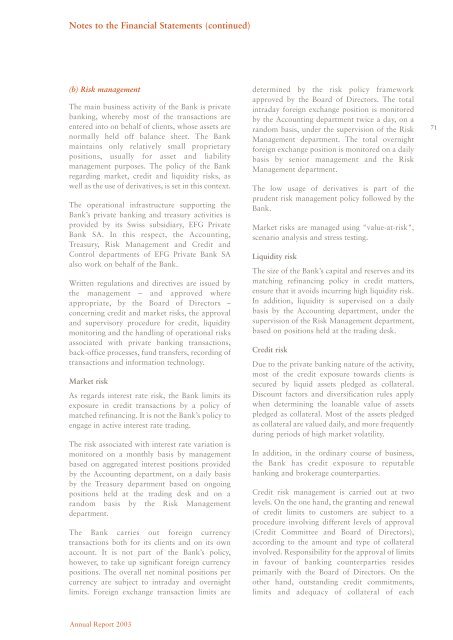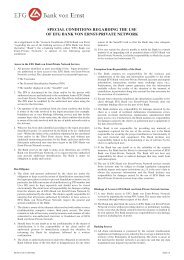as at December 31, 2003 - EFG Bank Group
as at December 31, 2003 - EFG Bank Group
as at December 31, 2003 - EFG Bank Group
Create successful ePaper yourself
Turn your PDF publications into a flip-book with our unique Google optimized e-Paper software.
Notes to the Financial St<strong>at</strong>ements (continued)<br />
(b) Risk management<br />
The main business activity of the <strong>Bank</strong> is priv<strong>at</strong>e<br />
banking, whereby most of the transactions are<br />
entered into on behalf of clients, whose <strong>as</strong>sets are<br />
normally held off balance sheet. The <strong>Bank</strong><br />
maintains only rel<strong>at</strong>ively small proprietary<br />
positions, usually for <strong>as</strong>set and liability<br />
management purposes. The policy of the <strong>Bank</strong><br />
regarding market, credit and liquidity risks, <strong>as</strong><br />
well <strong>as</strong> the use of deriv<strong>at</strong>ives, is set in this context.<br />
The oper<strong>at</strong>ional infr<strong>as</strong>tructure supporting the<br />
<strong>Bank</strong>’s priv<strong>at</strong>e banking and tre<strong>as</strong>ury activities is<br />
provided by its Swiss subsidiary, <strong>EFG</strong> Priv<strong>at</strong>e<br />
<strong>Bank</strong> SA. In this respect, the Accounting,<br />
Tre<strong>as</strong>ury, Risk Management and Credit and<br />
Control departments of <strong>EFG</strong> Priv<strong>at</strong>e <strong>Bank</strong> SA<br />
also work on behalf of the <strong>Bank</strong>.<br />
Written regul<strong>at</strong>ions and directives are issued by<br />
the management – and approved where<br />
appropri<strong>at</strong>e, by the Board of Directors –<br />
concerning credit and market risks, the approval<br />
and supervisory procedure for credit, liquidity<br />
monitoring and the handling of oper<strong>at</strong>ional risks<br />
<strong>as</strong>soci<strong>at</strong>ed with priv<strong>at</strong>e banking transactions,<br />
back-office processes, fund transfers, recording of<br />
transactions and inform<strong>at</strong>ion technology.<br />
Market risk<br />
As regards interest r<strong>at</strong>e risk, the <strong>Bank</strong> limits its<br />
exposure in credit transactions by a policy of<br />
m<strong>at</strong>ched refinancing. It is not the <strong>Bank</strong>’s policy to<br />
engage in active interest r<strong>at</strong>e trading.<br />
The risk <strong>as</strong>soci<strong>at</strong>ed with interest r<strong>at</strong>e vari<strong>at</strong>ion is<br />
monitored on a monthly b<strong>as</strong>is by management<br />
b<strong>as</strong>ed on aggreg<strong>at</strong>ed interest positions provided<br />
by the Accounting department, on a daily b<strong>as</strong>is<br />
by the Tre<strong>as</strong>ury department b<strong>as</strong>ed on ongoing<br />
positions held <strong>at</strong> the trading desk and on a<br />
random b<strong>as</strong>is by the Risk Management<br />
department.<br />
The <strong>Bank</strong> carries out foreign currency<br />
transactions both for its clients and on its own<br />
account. It is not part of the <strong>Bank</strong>’s policy,<br />
however, to take up significant foreign currency<br />
positions. The overall net nominal positions per<br />
currency are subject to intraday and overnight<br />
limits. Foreign exchange transaction limits are<br />
Annual Report <strong>2003</strong><br />
determined by the risk policy framework<br />
approved by the Board of Directors. The total<br />
intraday foreign exchange position is monitored<br />
by the Accounting department twice a day, on a<br />
random b<strong>as</strong>is, under the supervision of the Risk<br />
Management department. The total overnight<br />
foreign exchange position is monitored on a daily<br />
b<strong>as</strong>is by senior management and the Risk<br />
Management department.<br />
The low usage of deriv<strong>at</strong>ives is part of the<br />
prudent risk management policy followed by the<br />
<strong>Bank</strong>.<br />
Market risks are managed using "value-<strong>at</strong>-risk",<br />
scenario analysis and stress testing.<br />
Liquidity risk<br />
The size of the <strong>Bank</strong>’s capital and reserves and its<br />
m<strong>at</strong>ching refinancing policy in credit m<strong>at</strong>ters,<br />
ensure th<strong>at</strong> it avoids incurring high liquidity risk.<br />
In addition, liquidity is supervised on a daily<br />
b<strong>as</strong>is by the Accounting department, under the<br />
supervision of the Risk Management department,<br />
b<strong>as</strong>ed on positions held <strong>at</strong> the trading desk.<br />
Credit risk<br />
Due to the priv<strong>at</strong>e banking n<strong>at</strong>ure of the activity,<br />
most of the credit exposure towards clients is<br />
secured by liquid <strong>as</strong>sets pledged <strong>as</strong> coll<strong>at</strong>eral.<br />
Discount factors and diversific<strong>at</strong>ion rules apply<br />
when determining the loanable value of <strong>as</strong>sets<br />
pledged <strong>as</strong> coll<strong>at</strong>eral. Most of the <strong>as</strong>sets pledged<br />
<strong>as</strong> coll<strong>at</strong>eral are valued daily, and more frequently<br />
during periods of high market vol<strong>at</strong>ility.<br />
In addition, in the ordinary course of business,<br />
the <strong>Bank</strong> h<strong>as</strong> credit exposure to reputable<br />
banking and brokerage counterparties.<br />
Credit risk management is carried out <strong>at</strong> two<br />
levels. On the one hand, the granting and renewal<br />
of credit limits to customers are subject to a<br />
procedure involving different levels of approval<br />
(Credit Committee and Board of Directors),<br />
according to the amount and type of coll<strong>at</strong>eral<br />
involved. Responsibility for the approval of limits<br />
in favour of banking counterparties resides<br />
primarily with the Board of Directors. On the<br />
other hand, outstanding credit commitments,<br />
limits and adequacy of coll<strong>at</strong>eral of each<br />
71





